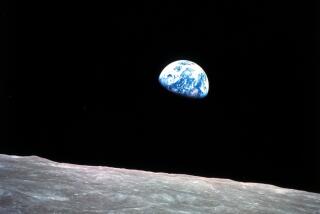Arthur Davidsen; Astrophysicist Led Work to Build Knowledge of Universe
- Share via
Arthur F. Davidsen, astrophysicist whose experiments aboard rockets and the space shuttle were fundamental in fathoming the structure of the universe, has died. He was 57.
Davidsen, who made his Johns Hopkins University a world leader in the field of astronomy, died Thursday in Baltimore of complications from a lung disorder.
The nationally respected professor of physics and astronomy was credited with bringing the Space Telescope Science Institute, operator of the Hubble Space Telescope, to Johns Hopkins. He also chaired the advisory council of the Sloan Digital Sky Survey, a national project that resulted in the first comprehensive digital encyclopedia covering a large fraction of the sky.
Davidsen made several pioneering contributions in the field of ultraviolet astronomy and advanced the study of materials found in the vast gulfs that lie between distant galaxies.
He also was the principal investigator for the Hopkins Ultraviolet Telescope, known as the HUT, an observatory that flew aboard space shuttles in 1990 and 1995.
His expectations were dashed during the 1990 flight when it was discovered that problems with the shuttle made it almost impossible to study the faint traces of ultraviolet light sources that were central to his research. But rather than miss an opportunity provided by the shuttle, he decided to use it to study brighter light sources, a project of his junior colleagues.
Davidsen and his team of astronomers designed the HUT to study unexplored regions of ultraviolet light that carried previously unknown data about distant stars, quasars and star clusters, and objects in the solar system such as Io, Jupiter’s moon.
The HUT’s voyages helped scientists understand that the intergalactic medium that formed galaxies long ago was not uniform.
“Data analyzed at Johns Hopkins fits the general picture of a hot Big Bang model very nicely, adding new evidence that science is on the right track for elucidating the master narrative of the universe,” David Dvorkin, curator of the Smithsonian’s National Air and Space Museum, said in a statement released by Johns Hopkins.
One of Davidsen’s early contributions was obtaining the first ultraviolet spectrum of a quasar via a rocket-mounted telescope. For the effort, he was awarded the Helen B. Warner Prize in 1979.
Born and reared in Freeport, N.Y., Davidsen by the age of 10 had read such classics in the field as “Realm of the Nebulae” by Edwin Hubble, “Creation of the Universe” by George Gamon and Fred Hoyle’s “Frontiers of Astronomy.”
He received a bachelor’s degree in physics from Princeton University in 1966. After serving in the Navy, he received master’s and doctoral degrees from UC Berkeley in 1975, the year he began his career at Johns Hopkins.
Davidsen is survived by his wife, Frauke; two sons, Andrew and Austin; two stepsons, Nick and Jesse Tischler; and one sister, Sylvia Klecak.




